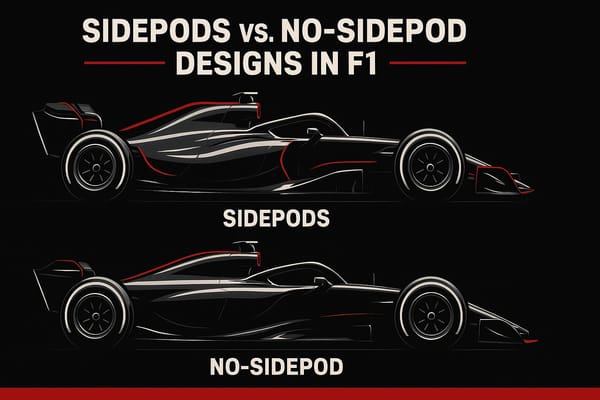Tyrrell P34: The 6-Wheel Experiment That Shocked F1
Explore the groundbreaking design and legacy of the only six-wheeled Formula One car, the Tyrrell P34, and its impact on motorsport innovation.

The Tyrrell P34 is the only six-wheeled Formula One car to win a Grand Prix, achieving this feat at the 1976 Swedish Grand Prix. Designed by Derek Gardner and introduced in 1975, its four smaller front wheels reduced drag and improved grip, challenging conventional F1 designs. Despite early success, including podium finishes and a 1–2 victory in Sweden, the P34 faced challenges in 1977. Limited tire development and aerodynamic issues led to its decline, and by 1978, Tyrrell returned to standard four-wheel designs. The P34 remains a symbol of bold engineering and innovation in motorsport history.
When 6 wheels shocked F1 | The story of the Tyrrell P34
Design and Engineering: A Closer Look at the P34
The P34 wasn't just a car; it was a bold experiment in pushing the boundaries of Formula One design. Chief designer Derek Gardner crafted every aspect of this six-wheeled marvel to take advantage of F1's physics and regulations. To truly understand the P34, we need to dive into three key areas: its daring four-wheel front-end concept, the engineering hurdles it introduced, and the critical role of custom tires. While groundbreaking, this design also brought with it a host of challenges that required equally creative solutions.
The Concept: 4 Small Front Wheels
At the heart of the P34's design was a clever solution to a tricky aerodynamic issue. F1 regulations on wing width left traditional front tires exposed, creating drag. Gardner’s ingenious response? Replace the standard two front wheels with four smaller 10-inch wheels. This allowed all the front wheels to fit neatly behind the wing, reducing drag and improving airflow over the car's body.
The benefits of this setup became clear almost immediately. When the P34 debuted at the 1976 Spanish Grand Prix in Jarama, it qualified third, trailing only James Hunt's McLaren and Niki Lauda's Ferrari. Beyond cutting drag, the four small wheels delivered superior grip compared to the usual two-tire setup. This enhanced front-end grip and cornering ability were particularly advantageous on tracks like Anderstorp in Sweden, where the P34 secured its historic Grand Prix win.
Engineering Challenges and Solutions
Building a six-wheeled F1 car was no small feat. One of the biggest challenges was the steering system. Only the leading front wheels were directly linked to the steering column, while a bell crank mechanism was used to transfer inputs to the second axle. This ensured both sets of front wheels turned in unison but added mechanical complexity and increased the risk of failure.
The suspension design also had to accommodate the extra wheels, making it bulkier and heavier than a standard four-wheeled setup. While extensive testing helped manage this added complexity, it still led to handling quirks and reliability issues. Braking was another persistent challenge - the unique layout placed significant stress on the system, leading to retirements despite ongoing improvements.
Derek Gardner later admitted that the development of the custom mini tires was "almost non-existent" compared to Goodyear's standard F1 tires, which ultimately limited the car's potential.
The Role of Goodyear Tires

Tires were a critical component in making the P34 concept work. Goodyear played a pivotal role as the only manufacturer willing to produce the specialized 10-inch tires required for the car’s unique front end. These weren’t just shrunken versions of standard F1 tires; they had to be engineered with new compounds and construction methods to handle the specific loads and heat cycles generated by the P34.
However, while Goodyear made strides with its regular F1 tire development during the 1976 and 1977 seasons, the custom tires for the P34 received little attention. The 1977 P34B, which featured a wider front track, inadvertently exposed the small wheels to airflow, negating the original design's aerodynamic advantage. This lack of tire development, combined with the car's inherent mechanical complexity, ultimately hindered its performance.
By 1978, Tyrrell abandoned the six-wheeled concept and returned to conventional designs. Even so, the P34 left a lasting mark on Formula One. Its inventive take on the regulations not only gave it a competitive edge during its time but also inspired other teams - like March, Ferrari, and Williams - to toy with six-wheeled designs in the years that followed, though these later experiments took a different approach.
The P34 remains a testament to the spirit of innovation in Formula One, a sport where bold ideas can redefine what's possible, even if only for a brief moment on the track.
The P34 on the Track: Successes and Setbacks
The Tyrrell P34’s journey in Formula One is a tale of bold innovation met with both early victories and eventual hurdles. From its impressive debut to the challenges that followed, the P34's story highlights both the promise and the pitfalls of unconventional engineering. Let’s take a closer look at its performance during the 1976 and 1977 seasons.
The 1976 Season: Early Triumphs
The P34's first competitive outing came at the 1976 Spanish Grand Prix in Jarama. Patrick Depailler made an immediate impression by qualifying third, trailing only James Hunt’s McLaren and Niki Lauda’s Ferrari. This was a staggering 11 places ahead of Tyrrell’s conventional car, making it clear that the six-wheeled design had potential.
Although Depailler’s race ended prematurely due to brake issues, the car’s speed was undeniable. Just a few races later, at the Monaco Grand Prix, the P34 truly came into its own. Both Depailler and Jody Scheckter secured podium finishes, with the car excelling on Monaco’s tight, twisting circuit where its enhanced front-end grip made a difference.
The high point of the season came at the Swedish Grand Prix at Anderstorp, where the P34 achieved an extraordinary 1–2 finish. Scheckter crossed the line first, with Depailler close behind. This victory cemented the P34’s place in history as the only six-wheeled car to win a Formula One race. By the end of the season, Tyrrell had secured third place in the Constructors' Championship, with the P34 contributing one race win and six podium finishes.
The 1977 Season: Decline and Retirement
Following its promising debut season, Tyrrell introduced the P34B for 1977, aiming to refine the groundbreaking design. However, the revised model faced a host of new challenges. Drivers Patrick Depailler and Ronnie Peterson struggled to find success, finishing a disappointing tenth and fourteenth respectively in the Drivers' Championship.
One of the key changes for 1977 was a wider front track, intended to boost mechanical grip. Unfortunately, this adjustment exposed the small front wheels to airflow, negating the aerodynamic advantages that had been central to the car’s initial success. To make matters worse, Goodyear decided to stop developing the specialized front tires that the P34 relied on. While their standard tire compounds continued to evolve, the bespoke tires for the P34 were left behind, leading to reduced grip and unpredictable handling.
| Season | Championship | Key Results | Challenges |
|---|---|---|---|
| 1976 | 3rd (Constructors') | 1 win, 6 podiums | Brake reliability |
| 1977 | Lower standings | No wins | Tire development stopped, aerodynamic issues |
By the end of 1977, it was clear that the P34 concept had run its course. Tyrrell made the decision to abandon the six-wheel experiment and returned to a conventional four-wheel design for the 1978 season.
Despite its brief time on the grid, the P34 left an indelible mark on Formula One. It demonstrated the potential of daring ideas while also highlighting the importance of sustained technical support from partners. The P34 remains one of the sport’s most intriguing designs - a symbol of the fine line between groundbreaking innovation and the challenges of execution.
Legacy of the Tyrrell P34
The Tyrrell P34 may have had a short run in active competition, but its influence on motorsport remains undeniable. This six-wheeled marvel left an indelible mark, showcasing the daring spirit of innovation while grappling with the practical challenges that come with pushing boundaries.
The Only 6-Wheeled Grand Prix Winner
The P34 holds a record that stands unmatched: it is the only six-wheeled car to ever win a Formula One Grand Prix. That historic moment came during the 1976 Swedish Grand Prix when Jody Scheckter led teammate Patrick Depailler to a stunning 1-2 finish. This victory not only secured its place in racing history but also helped Tyrrell clinch third place in the Constructors' Championship that season, with the car earning seven podiums along the way. It proved the P34 was more than just a novelty - it was a genuine contender on the track.
Reflecting on the P34, Jody Scheckter famously called it "the best car I ever drove" but also "the worst car I ever drove", highlighting its groundbreaking yet challenging design.
Regulatory Changes and the End of 6-Wheeled Cars
The P34’s success sparked a wave of interest in six-wheeled designs among other Formula One teams. Inspired by Tyrrell’s bold approach, several teams toyed with similar concepts. However, none of these designs ever made it to the starting grid or matched the P34’s achievements.
By the early 1980s, Formula One introduced regulations that effectively outlawed cars with more than four wheels. These rules, aimed at ensuring safety, practicality, and fairness, specifically banned designs with four driven wheels. The Williams FW08B prototype in 1982 marked the last serious attempt at a six-wheeled F1 car before the concept was permanently shelved. This regulatory shift not only ended the era of six-wheeled cars but also reignited debates about the balance between innovation and regulation in motorsport.
The P34 in Retrospect
Today, the Tyrrell P34 is celebrated as a symbol of Formula One’s willingness to embrace bold ideas. It frequently appears at historic racing events, like the Goodwood Festival of Speed, where it continues to captivate fans and inspire engineers with its daring design and unique history.
The P34’s journey - from revolutionary concept to technical challenges - offers valuable lessons about the interplay of risk and innovation in Formula One. Its decline also highlights the critical role of sustained technical partnerships, particularly with tire manufacturers, in supporting unconventional designs. More than just its striking appearance or its lone Grand Prix victory, the P34 represents a time when Formula One dared to think differently. It serves as a reminder that even fleeting moments of success can leave a lasting legacy in the world of motorsport.
Conclusion: Lessons from the Tyrrell P34
The Tyrrell P34's brief but memorable stint in Formula One offers a fascinating glimpse into the interplay between bold ideas and practical challenges. Its story highlights both the rewards of daring creativity and the tough realities that can derail even the most ambitious projects.
The P34 proved that groundbreaking ideas can shake up the status quo and deliver real results. As the only six-wheeled car to ever win a Grand Prix, it demonstrated how innovative thinking could lead to competitive advantages. Derek Gardner’s radical approach to design broke conventions, and the car’s victory at the 1976 Swedish Grand Prix showed that ingenuity could triumph over tradition.
However, the P34's journey also underscores how innovation can prompt change beyond its original intent. Gardner’s clever interpretation of the rules not only brought success but also triggered regulatory adjustments. Governing bodies eventually banned six-wheeled designs, ensuring that the P34 would remain a unique chapter in Formula One history.
The car’s decline serves as a cautionary tale about the importance of sustained collaboration. Goodyear’s decision to stop developing the specialized 10-inch tires ultimately sealed the P34’s fate. This highlights a key lesson: ambitious concepts demand full commitment from all involved parties. Modern Formula One teams have learned to ensure that their technical partners are fully aligned with their vision, a crucial takeaway from the P34’s story.
Despite its challenges, the P34's influence extended far beyond its single victory. It sparked a wave of creative engineering and inspired teams like March, Ferrari, and Williams to experiment with unconventional designs. While none of these prototypes matched the P34’s success, they reinforced the value of thinking outside the box - a mindset that remains an integral part of Formula One’s identity.
In today’s Formula One, stricter regulations and tighter budgets make projects like the P34 nearly impossible. The experimental freedom of the 1970s, which allowed such daring designs, simply doesn't exist in the modern era. Yet, the P34’s legacy endures as a testament to the power of bold innovation. Its story reminds us that even short-lived ideas can leave a lasting impact, inspiring engineers and fans to continue pushing the boundaries of possibility.
FAQs
Why did the Tyrrell P34, the revolutionary six-wheeled F1 car, lose its competitive edge?
The Tyrrell P34 made waves in Formula One with its bold six-wheel design, a concept aimed at boosting aerodynamics and enhancing tire grip. At first, the car's unique setup attracted significant attention, but its downfall was tied to a critical issue: tire development. The smaller front tires, custom-made specifically for the P34, became a problem when tire suppliers focused their efforts on standard sizes used by other teams. This left the P34 struggling to keep up as competitors continued to refine their cars.
On top of that, the P34's intricate design brought its own set of challenges. Maintenance was more complicated, and the car's added weight negatively affected its performance on the track. Coupled with shifts in F1 regulations and the sport's relentless drive for innovation, these issues ultimately sealed the P34's fate, leading to its retirement after just two seasons.
What was the impact of the Tyrrell P34's six-wheel design on its performance across different race tracks?
The Tyrrell P34 stood out in Formula One history with its daring six-wheel design, created to boost aerodynamics and tire grip. By incorporating four smaller front wheels, the car managed to cut down on drag while enhancing front-end stability - an edge that proved useful on tight, twisty circuits. However, on faster tracks, the design's complexity and issues with tire development became significant hurdles.
The P34 did enjoy moments of success, most notably its iconic victory at the 1976 Swedish Grand Prix. But consistency was a challenge. Teams struggled with the unique smaller front tires, both in sourcing and optimizing them, which eventually led to the car being retired from competition. Even with its brief time on the track, the P34 remains a lasting emblem of Formula One's willingness to push boundaries and explore bold engineering concepts.
Why were six-wheeled cars like the Tyrrell P34 banned in Formula One, and what impact did this have on car design innovations?
Six-wheeled cars, like the iconic Tyrrell P34, were officially banned from Formula One in 1983 when the FIA implemented a rule requiring cars to have only four wheels, with two driven wheels at the rear. The move aimed to simplify car designs and cut costs, as the development of six-wheeled vehicles proved to be a complex and resource-intensive challenge for teams and suppliers.
This ban marked a turning point in F1 innovation. Teams had to shift their focus, channeling their creativity into pushing the boundaries of four-wheel designs. While it brought an end to bold experiments like the P34, it spurred advancements in aerodynamics, materials, and other technologies - innovations that still influence the design of modern F1 cars today.




